| |
|

|
|
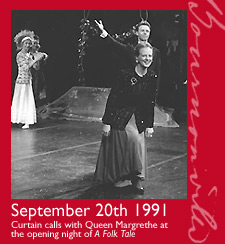
|
Intro
In 1991 Queen Margrethe II of Denmark created costumes and settings for the most Danish of all August Bournonville?s ballet A Folk Tale from 1854; the ballet had been inspired by Danish legends, by Hans Christian Andersen?s tales and had music provided by the most important Danish nineteenth-century composers J.P.E. Hartmann and N. W. Gade.
The Danish Royal Family had always taken a lively interest in the Royal Theatre, which, until 1849, was under the direct command of the king who often interfered in questions of repertoire and personnel. The Royal Family had also a keen interest in the theatre during the 20th century. Queen Margrethe?s paternal grandfather and father were both frequent guests in the royal box. The latter occasionally conducted the Royal Danish Orchestra at private concerts. However, Queen Margrethe is the first to join the ranks of professional artists. Seen historically, the 1991 production of A Folk Tale is also interesting in that one of the two directors Anne Marie Vessel Schlüter was married to the Danish Prime Minister, Poul Schlüter. In a way, this production represents the completion of Bournonville?s struggle to achieve social recognition for his artform and his artists. Dance in Denmark is on a par with all other art forms and dancers are just as much citizens as mysterious stage beings. They are still admired, but no longer decried.
|
|
|
 |
 |
 |
  
|
|
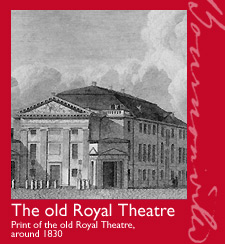
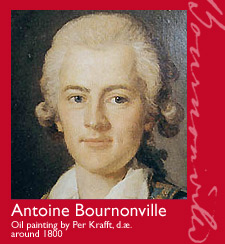
|
Ballet in the 18th century
There has always been dancing at the Royal Theatre. When the first Danish-language theatre opened in 1722 in Copenhagen?s Grønnegade with the comedies of Ludvig Holberg and Molière on the programme, dance was an important part of the entertainment, meant to pull the crowds, either as interlude in the plays or as divertissements in their own right. A French dancing-master was even employed by the theatre in 1726. This was Jean-Baptiste Landé, who later went to St. Petersburg, where he founded the Imperial Ballet. The international ties, which still bind Danish ballet to the major ballet countries, were characteristic from the beginning. Economic difficulties closed the Grønnegade theatre, and Great Fire in 1728 together with a pious royal family put an end to the theatrical enjoyment. In 1747, however, the theatre was revived and, in the following year, the actors moved into the theatre building on Kongens Nytorv and there was dance again, although there were only a few Danish ballet dancers. Most - both directors of the ballet and dancers - came from Germany, Italy and France. They came and went, but the theatre management was very interested in dance, which often proved the best means of attracting and entertaining a public still unused to the art of theatre.
The foundation was gradually laid for a Danish corps de ballet. In 1771 a school was founded which, to this day, is the backbone of the Royal Danish Ballet, and in 1775 the Italian Vincenzo Galeotti came to Copenhagen as balletmaster. In him the ballet had gained an artist with great international experience. He was responsible for the first important period of ballet in Denmark and he led the company right up to his death in 1816.
Galeotti introduced the ballet d?action, in which the plot is expressed in dance and pantomime. He also created dramatic works, which were often inspired by literature, basing ballets on the works of Voltaire and Shakespeare. Galeotti created the first Nordic ballet, Lagertha, which in 1801 ushered Romanticism into the Danish theatre. He also founded a tradition for collaboration with Danish composers, which subsequent directors of the company, August Bournonville, Harald Lander and Flemming Flindt, were to continue. Although Galeotti was the founder of the Danish Ballet, only one of his 49 works, The Whims of Cupid and the Ballet Master, from 1786, has survived. This is, however, the world?s oldest ballet, danced in unbroken tradition.
|
|
|
 |
 |
 |
  
|
|
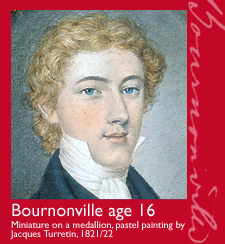
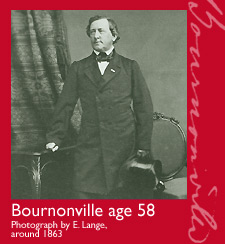
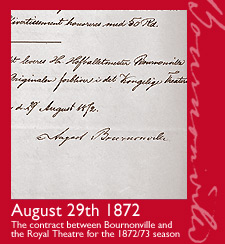
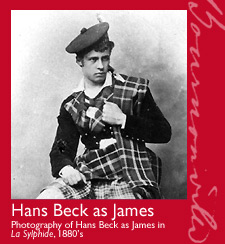
|
August Bournonville and his time
Danish ballet?s position on the international ballet stage is principally due to August Bournonville. He was born in Copenhagen in 1805, the same year as Hans Christian Andersen with whom he later became close friends. In 1830, at the age of only 25, he became responsible for ballet at the Royal Theatre. He held this position with little interruption until 1877. He was trained by Galeotti, as well as by his father, the accomplished French dancer Antoine Bournonville, who had arrived in Copenhagen from Stockholm in 1792. August Bournonville continued his training in the Paris of the 1820s and took home with him to Copenhagen the French dancing style in which elegance and grace dominate. In The Conservatoire (1849) he dramatized memories of his years of study in Paris. Bournonville was well aware of the demands and standards of the international world of ballet. He raised standards in Denmark to an international level of ability and at the same time gave it a unique national quality, which remains its distinctive characteristic, making it of interest abroad.
August Bournonville created dancers and he created a repertoire. It was due to him that Danish dancers achieved social equality with the other theatre artists and the citizens of the town. With his excellent dancing and the important position of male dance in his ballets, Bournonville created a tradition for male dance of a high standard. Male dance degenerated in most of Europe, but it remained strong in Denmark.
Bournonville staged about 50 ballets as well as numerous divertissements in opera and plays. He was a sublime man of the theatre and one of the few nineteenth-century Danes who kept up-to-date with international theatre developments. He knew what was going on in Europe, but, being the great personality he was, he went his own way, creating ballets in many genres. He produced straightforward and uncomplicated idyllic ballets such as Far from Denmark (1860) and The King?s Volunteers on Amager (1871). He created wonderful works based on folklore, such as the merry Flemish The Kermesse in Bruges (1851), the oriental Abdallah (1855) and, in addition, Norwegian, Italian and Spanish ballets. In the Valkyrie (1861) and The Lay of Thrym (1868) he created ballets based on Nordic mythology, but the major works, which are fortunately among the dozen or so ballets still performed, are La Sylphide (1836), Napoli (1842) and A Folk Tale (1854). These became the treasures of the Danish ballet repertoire and represent the essence of Bournonville?s outlook.
Despite the strong influence of France and French Romanticism, Bournonville?s art was very Danish. The attitude to life represented by his works is as far as could be imagined from European Romanticism and its preoccupation with disintegration and disharmony. With a firm foundation in the Danish Biedermeier tradition, Bournonville maintained that art should be positive, its purpose to elevate and help us to be harmonious beings. In these ideas Bournonville concourse with Danish writers and other artists of the time, who regarded art as a means to connect this world with a higher one? In his ballets Bournonville dedicates himself to a world of order, meaning, beauty and harmony, where the strongly erotic and the dramatic are cast away or defeated.
At Bournonville?s theatre a number of outstanding artists were trained to master dance and mime techniques. These are important elements of his ballets and continue to make special demands on Danish dancers. It was undoubted important for Bournonville?s dancers that they worked in the same building as the spoken drama, just as they do today. Many of Bournonville?s dancers have been forgotten, but a few names still shine. Lucile Grahn, who was his first Sylphide in 1836, subsequently became world-famous and performed all over Europe. Juliette Price, of the famous Price dancing family, was his favourite dancer and the first Hilda in A Folk Tale in 1854, while the first Nora in Henrik Ibsen?s play A Doll?s House was Betty Hennings, who had previously danced leading roles for August Bournonville. The premiere of Ibsen?s play took place in 1879, the year in which August Bournonville died. Two days before the choreographer?s death, he had been to the Royal Theatre and witnessed the debut of a young man by the name of Hans Beck. The young dancer enraptured Bournonville. Hans Beck subsequently became the motivating force in the preservation of the Bournonville tradition at the turn of the century.
|
|
|
 |
 |
 |
  
|
|
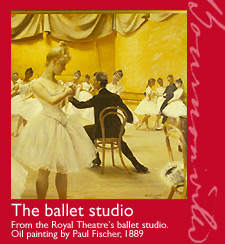
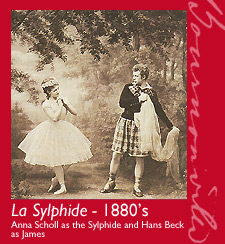
|
Hans Beck - Bournonville?s successor
In the 1890?s Hans Beck collected combinations of steps which had been devised by Bournonville in the classroom, as well as variations from his ballets, and formed the so-called Bournonville School; this became the Royal Danish Ballet?s training material for the following thirty to forty years. During the period of Naturalism - when Henrik Ibsen?s social dramas and the plays of August Strindberg, depicting the psychological war of nerves between the sexes, caused sensation and debate - the Royal Danish Ballet continued to dance Bournonville?s work as this was what the public wanted to see.
Fortunately for the Bournonville tradition Hans Beck concentrated on preserving rather than becoming a choreographer in his own right. His artistic ideals were the same as the old ballet master?s and his productions of August Bournonville?s works began the tradition with which all subsequent directors have had to battle.
But the Royal Danish Ballet is more than just August Bournonville, and the 20th century saw innovations. A difficult balance was initiated between the preservation of tradition and the creation of a modern company. From 1909 to 1929 Serge Diaghilev?s Les Ballets Russes had revitalized European ballet. The art form became sensual, new and young. The Russians possessed both wildness and lyricism. They had Europe at their feet. Audiences returned to the ballet in droves, but Diaghilev?s company never reached Denmark. However, in 1925, Mikhail Fokine came to Copenhagen as guest choreographer, staging Chopiniana (Les Sylphides), Petruochka and dances from Prince Igor and in 1930-31 a very young George Balanchine presented two ballet evenings which included performance of his neo-classical masterpiece Apollo - just two years after its premiere in Paris. But at this time Apollo was not yet recognised as a masterpiece. The Danish audience and Danish criticism considered it more gymnastics than art. It was given seven performances and did not return to the repertoire until the end of the 1950s. Bournonville was still the yardstick. His ideals of harmony and graceful dance still dominated, even though a young generation of both dancers and spectators had just about had enough.
|
|
|
 |
 |
 |
  
|
|
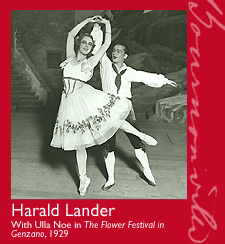
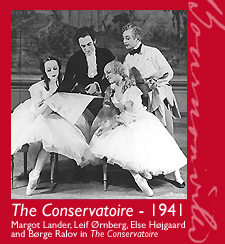
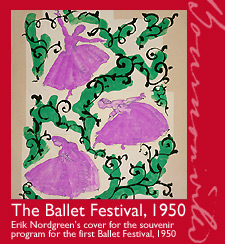
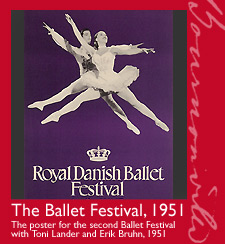
|
The Flowering of the Danish Ballet
In 1932 Harald Lander became ballet master at the Royal Theatre and his endeavours were to prove decisive in the transformation that Danish ballet was to undergo, as ballet became a modern art. Harald Lander had been inspired by Mikhail Fokine?s visit in 1925 and later studied with him in New York. Lander developed dancers and principals and created ballets which revealed dance as an art reflecting the modern condition, even though he always worked within the classical dance idiom. Bournonville?s ballets were put a little to one side for a while, but around 1940 Harald Lander looked at them again - with Valborg Borchsenius who had danced the leading roles at the turn of the century - he gave them the form which became the tradition and which they have largely retained to this day.
Following 50 years of unreflective Bournonville-dance, Harald Lander and Valborg Borchesenius took a fresh look at the ballets and discovered their qualities. Bournonville is a gifted storyteller and this ability to put a dramatic psychological story on stage has helped to cultivate the skilful mime which, to this very day, is a distinguishing feature of Danish dancers. At the same time, under Harald Lander?s direction, Bournonville?s dances became fresh and new. The infectious delight in dance, which is perhaps the most characteristic aspect of Bournonville?s choreography, was rediscovered and has prevailed ever since. There is a radiant happiness in Bournonville?s ballet shoes and this joy leaps from the stage and out into the audience in the dark auditorium. And it is because Bournonville?s ideals are lightness, the effortless and unforced, that his carefree dance, which sweeps all along with it, moves us. When the steps are executed with precision, of course.
At the end of Harald Lander?s period as ballet master, the Danish ballet realised that in Bournonville it possessed a ballet treasure unparallel in Europe. No other company has so many ballets which have been handed down directly from the Romantic period of the nineteenth century. But it also became apparent to Lander and his contemporaries that Bournonville alone is not enough if the ballet is to continue to attract interest. He must live on in an interaction with contemporary dance. Only then does his distinctive character manifest itself and achieve significance.
Whilst Harald Lander was ballet master Danish ballet was brought up to date. A training programme was gradually introduced which enabled the Danish dancers to present Swan Lake in a one-act version in 1938 and Aurora?s Wedding and the pas de deux from The Nutcracker in 1949. Russian technique was developed concurrently with Bournonville technique, which was kept in good order through the use of the Bournonville School. Harald Lander also created his own ballets. Maurice Ravel?s Boléro and La Valse were presented to the Danish audience in Lander?s choreography and, during the German occupation in the Second World War, both the Bournonville repertoire and Lander?s own ballets, including Festpolonaise, The Sorcerer?s Apprentice (Troldmandens Lærling) and Qarrtsiluni, were used as national symbols and artistic manifestations at a difficult time. Qarrtsiluni, with music by Knudåge Riisager, who was the most important Danish composer of the period, is a Greenland ballet in which the Eskimos sit throughout the long dark night awaiting the return of the sun. The symbolism was not difficult to grasp.
Harald Lander?s masterpiece, and the most frequently performed Danish ballet from the 20th century, was Etudes, created in 1948, again with music by Knudåge Riisager based on Czerny?s Etudes. The ballet follows the progress of a dancer, and a ballerina in particular, from the five positions and the daily class at the barre to the display on stage. It is a ballet about pure dance; from the training-études to the finished, liberated dance. For the next 50 years Etudes danced triumphantly across the ballet stages of the world. From Paris to Tokyo. From Toronto to Budapest. In the Denmark of 1948 this ballet meant that Harald Lander had mustered his corps, which had achieved an impressively high standard, around the prima ballerina Margot Lander who had been the centralizing figure in the 1930s and 1940s.
|
|
|
 |
 |
 |
  
|
|
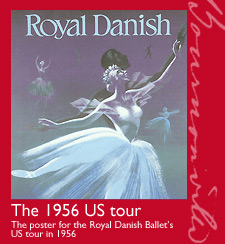
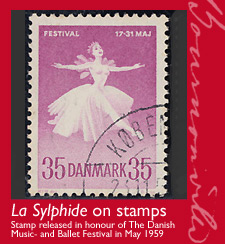
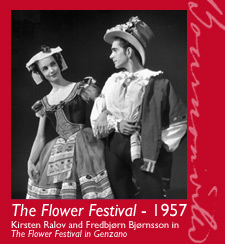
|
The Royal Danish Ballet in the 1950?s
During the 1950s the Royal Danish Ballet went international - in more ways than one way. The summer festivals drew the attention of foreign critics to the Danish ballet, which until then had largely been a domestic affair. This led to international guest performances and tours which today are a natural part of the Royal Danish Ballet?s activities. It began in London in 1955, continued in Edinburgh in 1955 and, with a tour of the USA in 1956, led to the great international breakthrough.
In the mid-1950s the Royal Danish Ballet was seen as a very strong company which had more than Bournonville to offer the international ballet world. Harald Lander had created a number of young dancers of remarkable quality and the Russian-British Vera Volkova who had come to Copenhagen in 1951 and worked as principal teacher for the next 24 years, gave the dancers their final polish. Together with the former Soviet Union, Denmark is the country which has exported most top male dancers to the world stage over the last 50 years. Included in this strong team of Danish dancers who astounded the world in the 1950s were the distinguished mimes Gerda Karstens and Niels Bjørn Larsen. The latter became Artistic director after Harald Lander and - apart from a few years, 1956-58, when Frank Schaufuss was at the helm - he was responsible for the development of the ballet right up to 1966.
During this period the repertoire became new and exciting. Harald Lander had already realised that renewal was important. In 1946 he incorporated Giselle into the repertoire and in 1948 he invited one of the great Diaghilev choreographers, Léonide Massine, to Copenhagen where he staged Le Beau Danube and Symphonie Fantastique. All the great choreographers then followed: George Balanchine, Birgit Cullberg, David Lichine, and Jerome Robbins. Frederick Ashton?s visit in 1955 was of special importance; he created his Romeo and Juliet for the Danish dancers. This was the first Western production to Sergei Prokofiev?s score. Birgit Cullberg created Moon Reindeer (Månerenen) in 1957 and her version of Strindberg?s Miss Julie was of huge importance to the development of young Danish character dancers, as was Roland Petit who, over the years, staged a number of works for the Royal Danish Ballet and provided the dancers with wonderful roles in Carmen, Cyrano de Bergerac, Le Loup and many other ballets, August Bournonville?s ballets were part of all this. It was Hans Brenaa who, with his great love and intuitive feeling for the essence of these works, directed and imbued them with life, thus taking care of the tradition right up until his death in 1988. Apart from the grand Romantic ballets, with their tension between this world and another which lies behind it like a yearning or a dream, Brenaa made the more straightforward and ingenuous ballets dance across the stage with an infectious vitality. During the periods in which Hans Brenaa was absent from the theatre, Kirsten Ralov was the custodian of the Bournonville tradition. In 1979 she committed the Bournonville Schools to paper.
|
|
|
 |
 |
 |
  
|
|
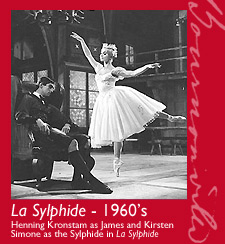
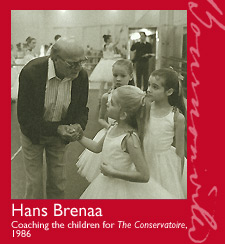
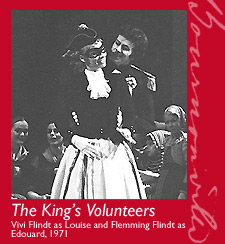
|
The Modern Time
Flemming Flindt was appointed Artistic Director in 1966 and something quite new was about to happen - Flemming Flindt was himself a choreographer with a mission and he wanted to modernize the ballet on Kongens Nytorv and attract a new audience. He made his debut as a choreographer with a ballet version of Eugène Ionesco?s La Leçon in 1963. With Flemming Flindt ballet became an art form which dealt with the here and now. Drawing inspiration from contemporary French writers, he created ?absurd? ballets as a mirror of the times - and as artistic protest: to discover the meaning that these works said was non-existent. There were two other ballets inspired by Ionesco: The Young Man Must Marry (Den Unge Mand Skal Giftes) in 1965, about sexual angst and women?s anger, with avant-garde music by Per Nørgaard and The Triumph of Death (Dødens Triumf) in 1971, which became the Royal Danish Ballet?s greatest success in the 20th century. This was a dance drama about the end of the world in which Flindt scored a success by commissioning the most popular rock group at the time, Savage Rose with the brothers Anders and Thomas Koppel, to write the music.
Flemming Flindt is a dynamic and intelligent man of the theatre. He created The Miraculous Mandarin (Den Forunderlige Mandarin) in 1967, but left the Royal Theatre in 1978 to work as a freelance choreographer. In 1991 he returned to Copenhagen with a full-length ballet about the Danish Queen Caroline Mathilde and her dramatic relationship to her husband the mad King Christian VII, and the King?s house physician Struensee, who became both Prime Minister and the Queen?s lover - A violent triangle from the end of the 18th century for which the British composer Sir Peter Maxwell Davies created a full, original score. Flindt?s latest work for the Danish ballet was Legs of Fire in 1998.
Flindt breaks with convention and has never accepted that ballet should simply be charming and attractive. Therefore he in his period as artistic director invited a new set of choreographers to the Royal Danish Ballet. In 1968 the American choreographer Paul Taylor staged Aureole at the Royal Theatre. It was the ballet?s first modern dance work and the first in which the classically trained company danced with bare feet. Later followed works by a series of USA?s leading exponents of contemporary dance: José Limon, Glen Tetley, Eliot Feld and Murray Louis all created works for the Royal Danish Ballet and the tradition continues with Alvin Ailey and right up to post-modernist choreographers as Laura Dean with Delta (1990) and Cloud (1994) and Lila York with Concerto in Pieces (2000).
|
|
|
 |
 |
 |
  
|
|
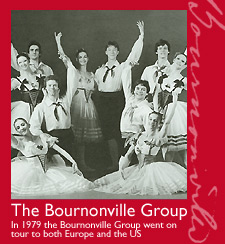
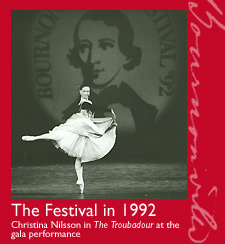
|
The Bournonville repertoire from 1979 to 1992
When Flemming Flindt left in 1978, Henning Kronstam became Artistic Director with Kirsten Ralov at his side as Associate Artistic Director. They got off to a tremendous start with the first Bournonville Festival in 1979 when the theatre used the occasion of the centenary of August Bournonville?s death to present all the directly handed-down ballets during the course of one week.
August Bournonville and the Royal Danish Ballet were well known abroad, but this week, with its concentrated presentation of a unique Romantic ballet tradition, was nevertheless a decisive international breakthrough.
The demand for Bournonville became greater than ever. The Royal Danish Ballet received countless invitations. Fame was of course both wonderful and intoxicating, but it also created problems because a classic dies if it is not constantly rethought. The renewal of the Bournonville repertoire during the 1980s was mainly based on the reconstruction of two forgotten Bournonville ballets and a series of shorter dances. Toni Lander Marks, Flemming Ryberg and Bruce Marks recreated Abdallah from 1855 - first for Ballet West in Salt Lake City in 1985 and later for The Royal Theatre in 1986. In 1990 Elsa Marianne von Rosen and Allan Fridericia recreated The Lay of Thrym from 1868. Added to this were the shorter dances which the Bournonville Group took around the world. On the initiative of Dinna Bjørn and Frank Andersen, a group of soloists had been touring since 1976 as Bournonville ambassadors, dancing in places where the whole company had not yet visited. These ?new? Bournonville dances - Jockey Dance and Polka Militaire - were created in attempt to expand the repertoire and go deeper into the tradition.
At the beginning of the 1990s new productions of well known ballets appear: A Folk Tale (1991) staged by Anne Marie Vessel Schlüter and Frank Andersen and Napoli (1992) staged by Dinna Bjørn, Frank Andersen and Henning Kronstam. A new generation of Bournonville experts is ready to develop the inheritance and tradition. Sorella Englund, Eva Kloborg and Flemming Ryberg should be added to the names already mentioned.
|
|
|
 |
 |
 |
  
|
|
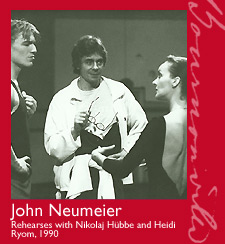
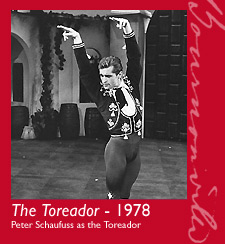
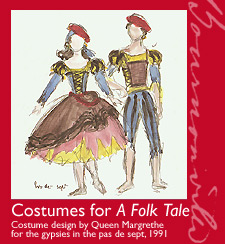
|
John Neumeier and New Danish choreographers
August Bournonville?s ballets possess many qualities. The light, captivating and infectious dance are the immediate asset, but what is possibly more interesting from an historical perspective, is their mixture of pantomime and dance. Bournonville?s century-old tradition of story ballets has produced special abilities in the Danish ballet. The dramatic-psychological ballets have become the driving force of the Royal Danish Ballet?s talent and the great artistic successes have come at the very time Danish ballet encountered a modern choreographer capable of telling a story through dance. In 1974 John Neumeier staged his Romeo and Juliet in Copenhagen and it was plain to see that the Danish dancers had a particular talent for entering into John Neumeier?s dramatic-narrative style. Neumeier returned in 1980 and he and the ballet had a great triumph with A Midsummer Night?s Dream, set in a Biedermeier milieu which, for a Danish audience, had associations to the period in which Bournonville created his ballets. Neumeier presented a middle-class milieu in which the erotic lurks under the respectable surface: but he feel for the erotic is of course far more daring than Bournonville?s and he has a different philosophy of life. In 1985 John Neumeier created a Hamlet ballet specially for the Royal Danish Ballet, in 1994 he staged his Mahler?s Fifth Symphony and Des Knaben Wunderhorn and for the 250 anniversary of The Royal Theatre in 1998 Neumeier contributed to the festivities with a pas deux Yesterday, danced to The Beatles. In these dramatic genre is also John Cranko?s Onegin, which the Danish ballet performed for the first time in 1989.
Choreographers do not grow on trees, either in Denmark or anywhere else in the world. Harald Lander and Flemming Flindt have been the dominating figures in the 20th century. During the 1960s and 1970s Eske Holm a principal dancer at the theatre, created a number of modern ballets, including an exciting new version of The Firebird in 1972. Elsa Marianne von Rosen created in the same period both dramatic and non-narrative works. In the 1980s Ib Andersen returned home from the New York City Ballet with a couple of short ballets. Anna Lærkesen - former ballerina with the company - did show great talent and development in a series of ballets in the 1990s like Partita (1990), Polacca (1992) and Kindertotenlieder (1992). From London came the Danish Kim Brandstrup back to Denmark and created Mysteries (1994) and Amor and Psyke (1997). The newest choreographic talent is Tim Rushton, who is English but danced with The Royal Danish Ballet for a number of years before he developed into a very interesting choreographer able to create both for modern companies in Denmark and for The Royal Danish Ballet, who has danced his Dominium (2000) and Nomade (2000) as well as some ballets for the children of the ballet school.
|
|
|
 |
 |
 |
  
|
|
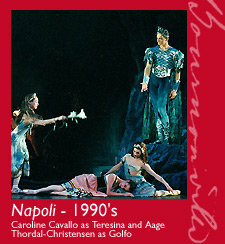
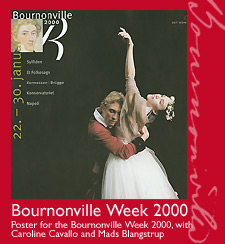
|
The Royal Danish Ballet in the 1990?s
Frank Andersen was Artistic Director 1985-1994 with Lise la Cour as his Associate Artistic Director. He was responsible for the Second Bournonville Festival in 1992, which also became a huge success and for the Balanchine-season 1992-93, where the company really brought Balanchine back to the repertory.
After Frank Andersen Peter Schaufuss was Artistic Director for one season 1994-95. He staged his own version of La Sylphide and it was his ambition to strengthen the Danish choreographic side. He invited young choreographers to perform at the theatre, he asked Peter Martins to stage four of his ballets and he ordered full-length ballets by Anna Lærkesen, Kim Brandstrup, Flemming Flindt, Peter Martins, while he himself created a Hamlet ballet. His period became very short and afterwards Johnny Eliasen, who has been Associate Director took over as temporarily appointed Artistic Director until Maina Gielgud was appointed in 1997. She was the first foreigner in this position since August Bournonville?s father Antoine Bournonville took the position in 1816, and she was the first woman. She presented a repertoire by Maurice Béjart (Gaité Parisienne (1998) Bhakti 3 (1997) and Boléro (1999)), Serge Lifar (Suite en Blanc (1998)), Ronald Hynd (The Merry Widow (1998)), Jerome Robbins (The Concert (1999)) and Jiri Kylian (Return to a Strange Land (1997)). Dinna Bjørn - Artistic Director for The Norwegian Ballet - was attached as Bournonville expert. She restaged the traditional version of La Sylphide and she, Anne Marie Vessel Schlüter and Jan Maagaard, who is a stage director, staged a new version of The Kermesse in Bruges at the mini Bournonville Festival the Theatre held in January 2000.
|
|
|
 |
 |
 |
 
|
|
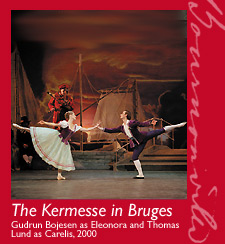
|
The New Millennium
In 1999 Maina Gielgud left and was succeeded by Aage Thordal-Christensen, a Danish dancer, educated in the Theatre in Copenhagen and with most of his dancing career in USA. His Associate Artistic Director was Henning Albrechtsen, while Aage Thordal-Christensen?s wife Colleen Neary, a former Balanchine ballerina from New York City Ballet, was instructor in chief. Once again Balanchine came back to the repertory with ballets danced earlier like Serenade and Symphony in C and new ballets like Violin Concerto. In the spring of 2001 Peter Martins went back to stage a whole evening with creations and in May new ballets by Alexei Ratmansky, principal dancer with the company, Tim Rushon and the Artistic director himself were performed. At Christmas 2001 a new lavish production of The Nutcracker choreographed by Alexei Ratmansky was performed in Tivoli Garden as part of a returning tradition. In April 2001 John Cranko?s interpretation of Alexander Pusjkin?s Onegin returned to the company. With the end of the season 2001-2002 Aage Thordal-Christensen left his position as Artistic Director, and the was succeed by former director Frank Andersen. In October 2002 Andersen brought in John Neumeier to create his 1995 interpertation of Homer?s The Odyssey - this was Neumeier's first major full length ballet for the company in years. With Andersen all sails are set to present the 3rd Bournonville Festival in June 2005 in celebration of Bournonville's 200th anniversary.
Erik Aschengreen: Professor (University of Copenhagen), Doctor of Philosophy (Dr. Phil), Dance critic.
|
|
|
 |
 |
 |





























